List of presidents of the United States
| This article is part of a series on the |
| Politics of the United States |
|---|
 |
|
The president of the United States is the head of state and head of government of the United States,[1] indirectly elected to a four-year term by the American people through the Electoral College.[2] The officeholder leads the executive branch of the federal government and is the commander-in-chief of the United States Armed Forces.[3]
Since the office was established in 1789, 45 people have served in 46 presidencies. The first president, George Washington, won a unanimous vote of the Electoral College;[4] one, Grover Cleveland, served two non-consecutive terms and is therefore counted as the 22nd and 24th president of the United States, giving rise to the discrepancy between the number of presidents and the number of persons who have served as president.[5]
The presidency of William Henry Harrison, who died 31 days after taking office in 1841, was the shortest in American history.[6] Franklin D. Roosevelt served the longest, over twelve years, before dying early in his fourth term in 1945. He is the only U.S. president to have served more than two terms.[7] Since the ratification of the Twenty-second Amendment to the United States Constitution in 1951, no person may be elected president more than twice, and no one who has served more than two years of a term to which someone else was elected may be elected more than once.[8]
Four presidents died in office of natural causes (William Henry Harrison, Zachary Taylor, Warren G. Harding, and Franklin D. Roosevelt), four were assassinated (Abraham Lincoln, James A. Garfield, William McKinley and John F. Kennedy), and one resigned (Richard Nixon, facing impeachment).[9] John Tyler was the first vice president to assume the presidency during a presidential term, and set the precedent that a vice president who does so becomes the fully functioning president with his presidency, as opposed to a caretaker president.[10] The Twenty-fifth Amendment to the Constitution put Tyler's precedent into law in 1967. It also established a mechanism by which an intra-term vacancy in the vice presidency could be filled. Richard Nixon was the first president to fill a vacancy under this provision when he selected Gerald Ford for the office following Spiro Agnew's resignation in 1973. The following year, Ford became the second to do so when he chose Nelson Rockefeller to succeed him after he acceded to the presidency. As no mechanism existed for filling an intra-term vacancy in the vice presidency before 1967, the office was left vacant until filled through the next ensuing presidential election and subsequent inauguration.[11]
Throughout most of its history, American politics has been dominated by political parties. The Constitution is silent on the issue of political parties, and at the time it came into force in 1789, no organized parties existed. Soon after the 1st Congress convened, factions began rallying around dominant Washington administration officials, such as Alexander Hamilton and Thomas Jefferson. Greatly concerned about the capacity of political parties to destroy the fragile unity holding the nation together, Washington remained unaffiliated with any political faction or party throughout his eight-year presidency. He was, and remains, the only U.S. president never affiliated with a political party.[12][13]
There are five living former presidents: Jimmy Carter, Bill Clinton, George W. Bush, Barack Obama, and Donald Trump. The most recent to die was George H. W. Bush, on November 30, 2018.[14][15]
Presidents
| Presidency[a] | Portrait | Name (Birth–Death) |
Party[b] | Election | Vice President | ||
|---|---|---|---|---|---|---|---|
| 1 | April 30, 1789 – March 4, 1797 |

|
George Washington (1732–1799) |
Unaffiliated | 1788–89 | John Adams[c] | |
| 1792 | |||||||
| 2 | March 4, 1797 – March 4, 1801 |

|
John Adams (1735–1826) |
Federalist | 1796 | Thomas Jefferson[d] | |
| 3 | March 4, 1801 – March 4, 1809 |

|
Thomas Jefferson (1743–1826) |
Democratic- Republican |
1800 | Aaron Burr | |
| 1804 | George Clinton[e] | ||||||
| 4 | March 4, 1809 – March 4, 1817 |

|
James Madison (1751–1836) |
Democratic- Republican |
1808 | ||
| Vacant after Apr. 20, 1812 | |||||||
| 1812 | Elbridge Gerry[e] | ||||||
| Vacant after Nov. 23, 1814 | |||||||
| 5 | March 4, 1817 – March 4, 1825 |

|
James Monroe (1758–1831) |
Democratic- Republican |
1816 | Daniel D. Tompkins | |
| 1820 | |||||||
| 6 | March 4, 1825 – March 4, 1829 |

|
John Quincy Adams (1767–1848) |
Democratic- Republican[f] |
1824 | John C. Calhoun[g][h] | |
| National Republican | |||||||
| 7 | March 4, 1829 – March 4, 1837 |

|
Andrew Jackson (1767–1845) |
Democratic | 1828 | ||
| Vacant after Dec. 28, 1832 | |||||||
| 1832 | Martin Van Buren | ||||||
| 8 | March 4, 1837 – March 4, 1841 |
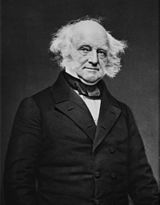
|
Martin Van Buren (1782–1862) |
Democratic | 1836 | Richard Mentor Johnson | |
| 9 | March 4, 1841 – April 4, 1841 |

|
William Henry Harrison[e] (1773–1841) |
Whig | 1840 | John Tyler | |
| 10 | April 4, 1841[i] – March 4, 1845 |

|
John Tyler (1790–1862) |
Whig[j] | Vacant throughout presidency | ||
| Unaffiliated | |||||||
| 11 | March 4, 1845 – March 4, 1849 |

|
James K. Polk (1795–1849) |
Democratic | 1844 | George M. Dallas | |
| 12 | March 4, 1849 – July 9, 1850 |

|
Zachary Taylor[e] (1784–1850) |
Whig | 1848 | Millard Fillmore | |
| 13 | July 9, 1850[k] – March 4, 1853 |

|
Millard Fillmore (1800–1874) |
Whig | Vacant throughout presidency | ||
| 14 | March 4, 1853 – March 4, 1857 |

|
Franklin Pierce (1804–1869) |
Democratic | 1852 | William R. King[e] | |
| Vacant after Apr. 18, 1853 | |||||||
| 15 | March 4, 1857 – March 4, 1861 |
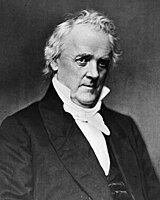
|
James Buchanan (1791–1868) |
Democratic | 1856 | John C. Breckinridge | |
| 16 | March 4, 1861 – April 15, 1865 |

|
Abraham Lincoln[l] (1809–1865) |
Republican | 1860 | Hannibal Hamlin | |
| National Union[m] | 1864 | Andrew Johnson | |||||
| 17 | April 15, 1865 – March 4, 1869 |

|
Andrew Johnson (1808–1875) |
National Union[n] | Vacant throughout presidency | ||
| Democratic | |||||||
| 18 | March 4, 1869 – March 4, 1877 |

|
Ulysses S. Grant (1822–1885) |
Republican | 1868 | Schuyler Colfax | |
| 1872 | Henry Wilson[e] | ||||||
| Vacant after Nov. 22, 1875 | |||||||
| 19 | March 4, 1877 – March 4, 1881 |

|
Rutherford B. Hayes (1822–1893) |
Republican | 1876 | William A. Wheeler | |
| 20 | March 4, 1881 – September 19, 1881 |

|
James A. Garfield[o] (1831–1881) |
Republican | 1880 | Chester A. Arthur | |
| 21 | September 19, 1881[p] – March 4, 1885 |
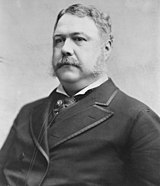
|
Chester A. Arthur (1829–1886) |
Republican | Vacant throughout presidency | ||
| 22 | March 4, 1885 – March 4, 1889 |

|
Grover Cleveland (1837–1908) |
Democratic | 1884 | Thomas A. Hendricks[e] | |
| Vacant after Nov. 25, 1885 | |||||||
| 23 | March 4, 1889 – March 4, 1893 |

|
Benjamin Harrison (1833–1901) |
Republican | 1888 | Levi P. Morton | |
| 24 | March 4, 1893 – March 4, 1897 |

|
Grover Cleveland (1837–1908) |
Democratic | 1892 | Adlai Stevenson I | |
| 25 | March 4, 1897 – September 14, 1901 |

|
William McKinley[q] (1843–1901) |
Republican | 1896 | Garret Hobart[e] | |
| Vacant after Nov. 21, 1899 | |||||||
| 1900 | Theodore Roosevelt | ||||||
| 26 | September 14, 1901 – March 4, 1909 |

|
Theodore Roosevelt (1858–1919) |
Republican | Vacant through Mar. 4, 1905 | ||
| 1904 | Charles W. Fairbanks | ||||||
| 27 | March 4, 1909 – March 4, 1913 |
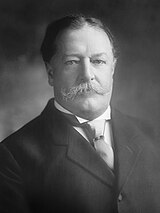
|
William Howard Taft (1857–1930) |
Republican | 1908 | James S. Sherman[e] | |
| Vacant after Oct. 30, 1912 | |||||||
| 28 | March 4, 1913 – March 4, 1921 |

|
Woodrow Wilson (1856–1924) |
Democratic | 1912 | Thomas R. Marshall | |
| 1916 | |||||||
| 29 | March 4, 1921 – August 2, 1923 |

|
Warren G. Harding[e] (1865–1923) |
Republican | 1920 | Calvin Coolidge | |
| 30 | August 2, 1923[r] – March 4, 1929 |

|
Calvin Coolidge (1872–1933) |
Republican | Vacant through Mar. 4, 1925 | ||
| 1924 | Charles G. Dawes | ||||||
| 31 | March 4, 1929 – March 4, 1933 |

|
Herbert Hoover (1874–1964) |
Republican | 1928 | Charles Curtis | |
| 32 | March 4, 1933 – April 12, 1945 |
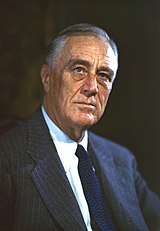
|
Franklin D. Roosevelt[e] (1882–1945) |
Democratic | 1932 | John Nance Garner | |
| 1936 | |||||||
| 1940 | Henry A. Wallace | ||||||
| 1944 | Harry S. Truman | ||||||
| 33 | April 12, 1945 – January 20, 1953 |

|
Harry S. Truman (1884–1972) |
Democratic | Vacant through Jan. 20, 1949 | ||
| 1948 | Alben W. Barkley | ||||||
| 34 | January 20, 1953 – January 20, 1961 |

|
Dwight D. Eisenhower (1890–1969) |
Republican | 1952 | Richard Nixon | |
| 1956 | |||||||
| 35 | January 20, 1961 – November 22, 1963 |

|
John F. Kennedy[s] (1917–1963) |
Democratic | 1960 | Lyndon B. Johnson | |
| 36 | November 22, 1963 – January 20, 1969 |
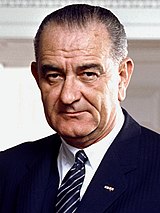
|
Lyndon B. Johnson (1908–1973) |
Democratic | Vacant through Jan. 20, 1965 | ||
| 1964 | Hubert Humphrey | ||||||
| 37 | January 20, 1969 – August 9, 1974 |

|
Richard Nixon[h] (1913–1994) |
Republican | 1968 | Spiro Agnew[h] | |
| 1972 | |||||||
| Vacant, Oct. 10 – Dec. 6, 1973 | |||||||
| Gerald Ford[t] | |||||||
| 38 | August 9, 1974 – January 20, 1977 |
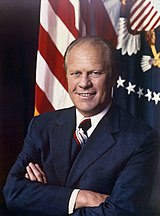
|
Gerald Ford (1913–2006) |
Republican | Vacant through Dec. 19, 1974 | ||
| Nelson Rockefeller[t] | |||||||
| 39 | January 20, 1977 – January 20, 1981 |

|
Jimmy Carter (b. 1924) |
Democratic | 1976 | Walter Mondale | |
| 40 | January 20, 1981 – January 20, 1989 |
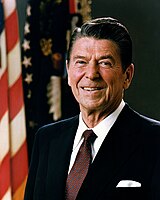
|
Ronald Reagan (1911–2004) |
Republican | 1980 | George H. W. Bush | |
| 1984 | |||||||
| 41 | January 20, 1989 – January 20, 1993 |

|
George H. W. Bush (1924–2018) |
Republican | 1988 | Dan Quayle | |
| 42 | January 20, 1993 – January 20, 2001 |

|
Bill Clinton (b. 1946) |
Democratic | 1992 | Al Gore | |
| 1996 | |||||||
| 43 | January 20, 2001 – January 20, 2009 |

|
George W. Bush (b. 1946) |
Republican | 2000 | Dick Cheney | |
| 2004 | |||||||
| 44 | January 20, 2009 – January 20, 2017 |

|
Barack Obama (b. 1961) |
Democratic | 2008 | Joe Biden | |
| 2012 | |||||||
| 45 | January 20, 2017 – January 20, 2021 |
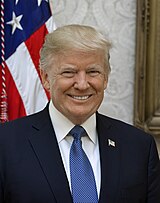
|
Donald Trump (b. 1946) |
Republican | 2016 | Mike Pence | |
| 46 | January 20, 2021 – Incumbent |
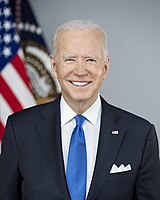
|
Joe Biden (b. 1942) |
Democratic | 2020 | Kamala Harris | |
| Sources:[16][17][18] | |||||||
See also
- Acting president of the United States
- Founding Fathers of the United States
- President of the Continental Congress
Notes
- ^ Presidents are numbered according to uninterrupted periods served by the same person. For example, George Washington served two consecutive terms and is counted as the first president (not the first and second). Upon the resignation of 37th president Richard Nixon, Gerald Ford became the 38th president even though he simply served out the remainder of Nixon's second term and was never elected to the presidency in his own right. Grover Cleveland was both the 22nd president and the 24th president because his two terms were not consecutive. A vice president who temporarily becomes acting president under the Twenty-fifth Amendment to the Constitution is not counted, because the president remains in office during such a period.
- ^ Reflects the president's political party at the start of their presidency. Changes during their time in office are noted. Also reflects the vice president's political party unless otherwise noted beside the individual's name.
- ^ Political parties had not been anticipated when the Constitution was drafted in 1787 and ratified in 1788, nor did they exist at the time of the first presidential election in 1788–89. When they did develop, during Washington's first term, Adams joined the faction that became the Federalist Party. The elections of 1792 were the first ones in the United States that were contested on anything resembling a partisan basis.
- ^ The 1796 presidential election was the first contested American presidential election and the only one in which a president and vice president were elected from opposing political parties. Federalist John Adams was elected president, and Jefferson of the Democratic-Republicans was elected vice president.
- ^ a b c d e f g h i j k Died in office of natural causes.
- ^ Early during Adams' term the Democratic-Republican Party dissolved; his allies in Congress and at the state-level were referred to as "Adams' Men" during the Adams presidency. When Andrew Jackson became president in 1829, this group became the "Anti-Jackson" opposition, and organized themselves as the National Republican Party.
- ^ John Calhoun, formerly a Democratic-Republican, founded the Nullifier Party in 1828 to oppose the Tariff of 1828 and advance the cause of states' rights, but was brought on as Andrew Jackson's running mate in the 1828 presidential election in an effort to broaden the democratic coalition led by Jackson.
- ^ a b c Resigned from office
- ^ John Tyler was sworn in as president on April 6, 1841.
- ^ John Tyler was elected vice president on the Whig Party ticket in 1840. His policy priorities as president soon proved to be opposed to most of the Whig agenda, and he was expelled from the party in September 1841.
- ^ Millard Fillmore was sworn in as president on July 10, 1850.
- ^ Died April 15, 1865; see Assassination of Abraham Lincoln for further details.
- ^ When he ran for reelection in 1864, Republican Abraham Lincoln formed a bipartisan electoral alliance with War Democrats by selecting Democrat Andrew Johnson as his running mate, and running on the National Union Party ticket.
- ^ While president, Johnson tried and failed to build a party of loyalists under the National Union banner. Near the end of his presidency, Johnson rejoined the Democratic Party.
- ^ Died September 19, 1881; see Assassination of James A. Garfield for further details.
- ^ Chester A. Arthur was initially sworn in as president on September 20, 1881, and then again on September 22.
- ^ Died September 14, 1901; see Assassination of William McKinley for further details.
- ^ Calvin Coolidge was initially sworn in as president on August 3, 1923, and then again on August 21.
- ^ Died November 22, 1963; see Assassination of John F. Kennedy for further details.
- ^ a b Appointed as vice president under terms of the Twenty-fifth Amendment, Section 2.
References
- ^ Rossiter, Clinton (1962). "Powers of the United States President and Congress". Pakistan Horizon. Pakistan Institute of International Affairs. 15 (2): 86. JSTOR 41392704.
- ^ Shugart, Matthew S. (2004). "Elections': The American Process of Selecting a President: A Comparative Perspective". Presidential Studies Quarterly. Center for Congressional and Presidential Studies. 34 (3): 633–636. doi:10.1111/j.1741-5705.2004.00216.x. JSTOR 27552617.
- ^ Fairman, Charles (1949). "The President as Commander-in-Chief". The Journal of Politics. University of Chicago Press. 11 (1): 145–146. doi:10.2307/2126503. JSTOR 2126503. S2CID 155029239.
- ^ Matuz, Roger (2001). Complete American Presidents Sourcebook. UXL. p. xxii. ISBN 978-0-7876-4842-8. LCCN 00056794. OL 24722725M.
- ^ Schaller, Thomas F.; Williams, Thomas W. (2003). "'The Contemporary Presidency': Postpresidential Influence in the Postmodern Era". Presidential Studies Quarterly. Center for Congressional and Presidential Studies. 33 (1): 192. JSTOR 27552468.
- ^ McHugh, Jane; Mackowiak, Philip A. (2014). "Death in the White House: President William Henry Harrison's Atypical Pneumonia". Clinical Infectious Diseases. Oxford University Press. 59 (7): 990–995. doi:10.1093/cid/ciu470. JSTOR 24032403. PMID 24962997.
- ^ Skau, George H. (1974). "Franklin D. Roosevelt and the Expansion of Presidential Power". Current History. University of California Press. 66 (394): 246–275. JSTOR 45313079.
- ^ Willis, Paul G.; Willis, George L. (1952). "The Politics of the Twenty-Second Amendment". The Western Political Quarterly. University of Utah Press. 5 (3): 473. doi:10.2307/442606. JSTOR 442606.
- ^ Abbott, Philip (2005). "Accidental Presidents: Death, Assassination, Resignation, and Democratic Succession". Presidential Studies Quarterly. Wiley. 35 (4): 627–644. doi:10.1111/j.1741-5705.2005.00269.x. ISSN 0360-4918. JSTOR 27552721.
- ^ Dinnerstein, Leonard (1962). "The Accession of John Tyler to the Presidency". Virginia Magazine of History and Biography. Virginia Historical Society. 70 (4): 447–451. JSTOR 4246893.
- ^ Kassop, Nancy (2005). "'The Law': When Law and Politics Collide: Presidents and the Use of the Twenty-Fifth Amendment". Presidential Studies Quarterly. Wiley. 35 (1): 147–153. doi:10.1111/j.1741-5705.2004.00240.x. JSTOR 27552664.
- ^ Seasongood, Murray (1932). "George Washington and Political Parties". The American Scholar. Vol. 1 no. 3. Phi Beta Kappa. pp. 265–271.
- ^ Jamison, Dennis (December 31, 2014). "George Washington' Views on Political Parties in America". The Washington Times. Retrieved February 20, 2020.
- ^ Tumulty, Karen (November 30, 2018). "George H.W. Bush, 41st President of the United States, Dies at 94". The Washington Post. Retrieved November 23, 2021.
- ^ Horsley, Scott; Rosenbaum, Marcus; Kesbeh, Dina (November 30, 2018). "Former President George H.W. Bush Dies At 94". NPR. Retrieved January 11, 2022.
- ^ "Presidents". whitehouse.gov. Washington, D.C.: White House. Retrieved February 20, 2020.
- ^ "Chronological List of Presidents, First Ladies, and Vice Presidents of the United States". Washington, D.C.: Prints and Photographs Division, Library of Congress. Retrieved February 20, 2020.
- ^ Kelly, Martin (February 17, 2020). "Chart of the Presidents and Vice Presidents". thoughtco.com. New York City: Dotdash. Retrieved February 20, 2020.
External links
| Wikimedia Commons has media related to President of the United States. |
| Wikiquote has quotations related to: List of presidents of the United States |
- Whitehouse.gov: The Presidents
- Hauenstein Center | Presidential Leadership Studies at Grand Valley State University
- Lists of national presidents
- Lists relating to the United States presidency
- Presidents of the United States
